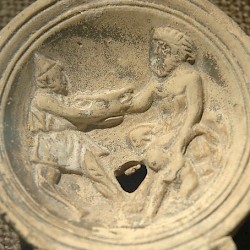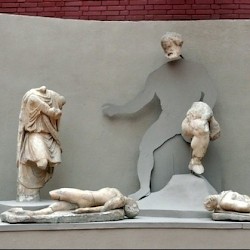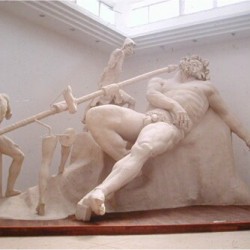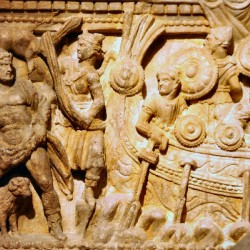Cyclopes
Cyclopes (Greek Κύκλωπες): name of mythological giants who had one round eye, set in the middle of the forehead. The most famous story about a Cyclops is Homer’s tale of Polyphemus, who was blinded by Odysseus.
Homeric shepherds
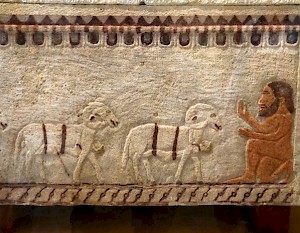
The ancient Greeks had several stories about the Cyclopes, "round-eyed people".note The oldest one of these is included in the ninth book of Homer’s Odyssey. After landing on an island, Odysseus and twelve companions are taken captive by Polyphemus, a son of Poseidon, who keeps them in a cave with his sheep and starts to devour his human visitors. The Greek hero offers some wine to the Cyclops, who promises that Odysseus will be the last one he will eat. When Polyphemus asks Odysseus’ name, he answers that his name is Nobody.
During the night, when Polyphemus is sleeping, Odysseus manages to blind his captor. In the morning, he and his companions can escape by hiding themselves underneath the sheep that Polyphemus allows to leave the cave. When the other Cyclopes find their blind friend, he explains that nobody has blinded him, and is left alone by the others. Sailing away, Odysseus shouts several insults to Polyphemus, who throws a big rock but misses, and curses the man who has blinded him.
Following in the footsteps of Homer, the Hellenistic poets Philoxenus of Cythera and Theocritus presented Polyphemus as crazy in love with a nymph called Galatea. When the Cyclops kills his rival Acis, she changes Acis' blood into a river on Sicily. This story is best known from the Roman poet Ovid.note
Hesiodic smiths
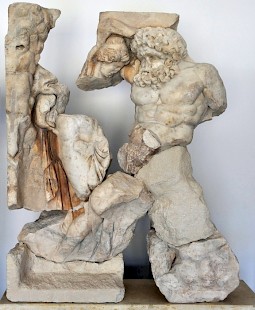
Homer’s younger contemporary Hesiod and the author of the Titanomachy present completely different Cyclopes: called Brontes, Steropes, and Arges, they are the sons of Uranus and Gaia (i.e., Heaven and Earth),note and are kept in custody in the Tartaros by Kronos. Zeus frees them and they give him the lightnings and thunderbolts that will be his weapon.
He freed his uncles from their dreadful bonds,
The sons of Heaven; his father, foolishly,
Had bound them. They remembered gratitude
And gave him thunder and the blazing bold
And lightning, which, before, vast Earth had hid.note
Hesiod inspired later authors. The Hellenistic poet Callimachus presents the Cyclopes as living on Lipara, where they are the assistants of Hephaestus and make Artemis' silver bow.note The Roman poet Virgil mentions these smith-Cyclopes as assistants of Vulcan. Living underneath the Etna, they are the makers of the panoply of Aeneas.note} Another tradition has it that these Cyclopes were killed by Apollo.note
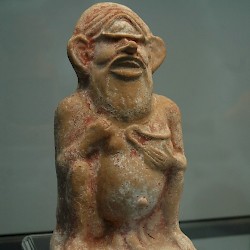 Cyclops |
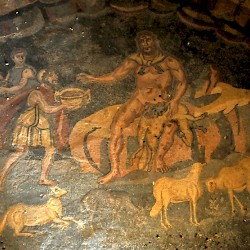 Piazza Armerina, Vestibule, Odysseus and Polyphemus |
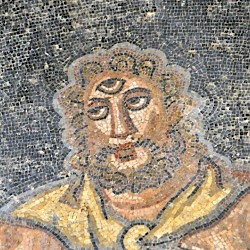 Piazza Armerina, Vestibule, Polyphemus |
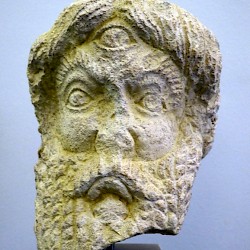 Salona, Cyclops |
Master builders and three-eyed Cyclopes
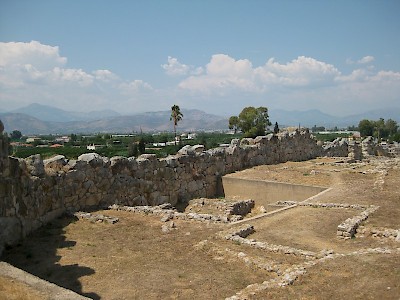
A completely different tradition, attested in the Guide to Greece by Pausanias, makes the Cyclopes responsible for constructing the “cyclopean walls” of large boulders, which surrounded ancient cities like Mycenae or Tiryns.
Nothing is left of the ruins [of Tiryns] except the wall, which was built by Cyclopes with natural rocks, all so huge that a pair of mules would not even begin to shift the smallest. In ancient times, little stones were fitted in to bind the rocks together.note
The Cyclopes were also credited with creating the famous Lion Gate of Mycenae.note
In Roman art, Cyclopes are often shown with three eyes: a normal face, to which the round eye is added in the middle of the forehead.
